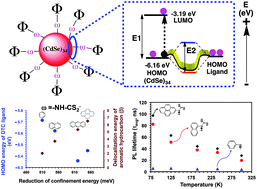Elucidating the role of surface passivating ligand structural parameters in hole wave function delocalization in semiconductor cluster molecules†
Abstract
This article describes the mechanisms underlying electronic interactions between surface passivating ligands and (CdSe)34 semiconductor cluster molecules (SCMs) that facilitate band-gap engineering through the delocalization of hole wave functions without altering their inorganic core. We show here both experimentally and through density functional theory calculations that the expansion of the hole wave function beyond the SCM boundary into the ligand monolayer depends not only on the pre-binding energetic alignment of interfacial orbitals between the SCM and surface passivating ligands but is also strongly influenced by definable ligand structural parameters such as the extent of their π-conjugation [π-delocalization energy; pyrene (Py), anthracene (Anth), naphthalene (Naph), and phenyl (Ph)], binding mode [dithiocarbamate (DTC, –NH–CS2−), carboxylate (–COO−), and amine (–NH2)], and binding head group [–SH, –SeH, and –TeH]. We observe an unprecedentedly large ∼650 meV red-shift in the lowest energy optical absorption band of (CdSe)34 SCMs upon passivating their surface with Py-DTC ligands and the trend is found to be Ph- < Naph- < Anth- < Py-DTC. This shift is reversible upon removal of Py-DTC by triethylphosphine gold(I) chloride treatment at room temperature. Furthermore, we performed temperature-dependent (80–300 K) photoluminescence lifetime measurements, which show longer lifetime at lower temperature, suggesting a strong influence of hole wave function delocalization rather than carrier trapping and/or phonon-mediated relaxation. Taken together, knowledge of how ligands electronically interact with the SCM surface is crucial to semiconductor nanomaterial research in general because it allows the tuning of electronic properties of nanomaterials for better charge separation and enhanced charge transfer, which in turn will increase optoelectronic device and photocatalytic efficiencies.



 Please wait while we load your content...
Please wait while we load your content...